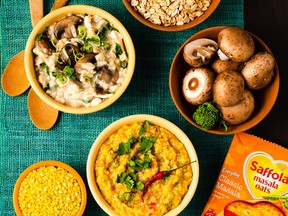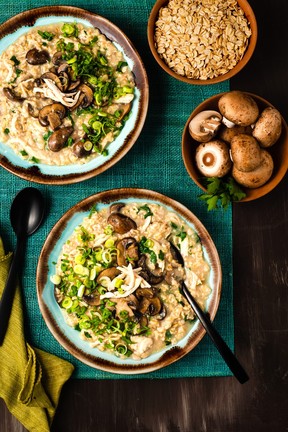Reviews and recommendations are unbiased and products are independently selected. Postmedia may earn an affiliate commission from purchases made through links on this page.
Delicious gruels can be made from almost any cracked or rolled grain

Gruel didn’t always have the Dickensian workhouse and food-for-invalids’ reputation it has now; it was eaten by everyone.

Article content
I was having trouble deciding what angle to approach this column from. I love “gruel”, but I also have to acknowledge the cost of food. It’s crazy expensive. I wanted to make lettuce wraps a short while back but there was no way I was going to pay $6.99 for a head of leaf lettuce so I bought napa cabbage, a.k.a. sui choi, instead.
Advertisement 2
Article content
It was great as a “lettuce” wrap plus I could use the rest of it as a cooked vegetable later. I think that’s the key to eating right now; reconsidering what we buy, eat, and how we cook it.
Article content
Gruel didn’t always have the Dickensian workhouse and food-for-invalids’ reputation it has now; it was eaten by everyone. Some historic gruels were quite fancy with herbs, fruit, eggs, alcohol and meat. It’s probably one of the most ancient ways of cooking grains, easily chewable, warm and comforting.
In medieval Europe, serfs weren’t allowed to grind their own grains, they had to be ground by a miller — for a fee — with a portion of it going to the lord of the manor. A way around that was to crack the grains with a mortar and pestle or other instrument and turn it into gruel.
Advertisement 3
Article content
My gruel journey started with my first bowl of congee in 1982. A big white bowl was presented to me cradling thin rice porridge, studded with tiny bits of barbecue duck, a healthy dose of green onions and julienned ginger. There was no salt in it, that was something you did yourself along with copious shakes of white pepper. The rice was creamy and soothing with just enough ducky bits to provide a pop of flavour every few spoonfuls and I became an instant convert. It was also very easy to make with a small amount of rice or cooked, leftover rice.
My Lao friends taught me their version, which was seasoned with fried garlic, chilies, cilantro and fish sauce. They would also beat a raw egg into the molten rice, which made it silky and smooth. After noting a package of chicken-flavoured oatmeal in Hong Kong, then making a thin porridge with chicken in it for myself, I saw the appeal. It became my quick, go-to meal, and was wonderful with tiny cubes of aged cheddar melting into it. Sometimes I would use canned tuna, since it was always in the cupboard.
Advertisement 4
Article content
Delicious gruels can be made from almost any cracked or rolled grain. They’re practically a hands-off form of cooking: once the pot is on, you can pretty much walk away and the prevalence of electric pressure cookers has made it even easier.
And it’s cheap. One cooked chicken breast can become a meal for two or you can take the plant-based route with the recipe for khichidi that I’ve included. I hope you’ll learn to love it as much as I do.

Khichidi
In India, khichidi is an easy and warming meal that covers breakfast, lunch and dinner. Feel free to add vegetables; spinach, kale, carrots and cauliflower are all good choices.
You’re probably no stranger to mung beans, they’re the beans used to grow bean sprouts. Split and hulled mung beans can be found in the international sections of grocery stores. You can sub red split lentils but the mung beans provide the best results.
Advertisement 5
Article content
1/2 cup (125 mL) rice
1/2 cup (125 mL) split and hulled mung beans
1/2 tsp (2.5 mL) turmeric
1 tsp (5 mL) salt
5 cups (1.25 L) water
2 tbsp (30 mL) ghee, unsalted butter or coconut oil
1 tsp (5 mL) cumin seeds
1 bay leaf
1 cup (250 mL) finely chopped onion
1 tsp (5 mL) minced ginger
2 medium tomatoes, finely chopped
1/2 tsp (2.5 mL) garam masala
Chopped cilantro for garnish
Combine the rice and mung beans in a bowl and clean by adding water, swirling it around with your hand then pouring off the water. Repeat 3-4 times. Cover with water and let sit while you prepare the rest of the ingredients.
Drain the rice and beans and place in a pot large enough to hold everything comfortably. Bring to a boil over high heat then turn to a simmer. Skim off any foam. Add the turmeric; cover and cook for 45-60 minutes until the rice mixture is falling apart tender. The texture should be thick but adjust it to your liking by adding water.
Advertisement 6
Article content
While the rice mixture cooks, heat the ghee in a medium frying pan over medium low heat. Add the cumin seeds and bay leaf. Saute until the cumin is fragrant. Add the onions and ginger. Cook until the onions are very soft but not browned then add the tomatoes. Cook until the tomatoes are thick and pasty. Stir in the garam masala and remove from the heat.
When the rice mixture is done, add the tomato mixture and mix well. Check the seasoning and texture, adjusting as desired.
Makes 2-3 servings.

Oats with Chicken, Mushrooms and Spinach
Think of this recipe as a guideline. Add cheese, different proteins and your favourite vegetables.
3 cups (750 mL) water
1 cup (250 mL) old-fashioned rolled oats
1/2 tsp (2.5 mL) salt
2 tbsp (30 mL) olive oil
Advertisement 7
Article content
2 cups (500 mL) sliced, fresh button mushrooms
1 cup (250 mL) cooked, shredded chicken
1 cup (250 mL) coarsely chopped fresh spinach
1 green onion, thinly sliced
Bring the water, oats and salt to a boil in a pot that will hold all the ingredients comfortably. Cover and turn to a simmer for 9 minutes.
Heat the oil over high heat in a frying pan that will hold the mushrooms comfortably. Add the mushrooms and cook, stirring frequently until the mushrooms soften. When the oats hit the 9 minute mark, add the mushrooms, chicken and spinach. Cook for 2 minutes to wilt the spinach and heat the chicken. Transfer to bowls and garnish with the green onion.
Makes 2 servings.
Source: vancouversun.com


